Rules for Singapore Mahjong - Updated June 18, 2002
A Word About Standard Rules
There is no standard way to play
Mahjong. Each country, region, and even household may play with a different
set of rules. However, there is a good portion of the rules that remain
common throughout most of the
different variations that are played. Rule
differences are pointed out below when know.
The Tile Set
The tile set is made up of 148 tiles. These 148 tiles
are broken into suits that contain 136 total playable tiles,
flower suit
tiles that contain 8 tiles, and animal suit tiles that contain 4 tiles.
The Bamboo, Circle, and Numbers suits.
There are 36 tiles each of
the Circle, Bamboo, and Numbers Suit. Each one of these suits has numerical
tiles
ranging from one to nine containing 4 tiles for each number in the
suit. These tiles are shown below.
![]() Bamboo Suit
Bamboo Suit
![]() Circle Suit
Circle Suit
![]() Numbers Suit
Numbers Suit
The Honor suit
The Honor Suit is made up of 2 types of tiles, the
Dragon Tiles and the Wind Tiles which are explained below.
The Dragon Tiles.
There are three unique tiles within the dragon
suit with each unique tile having four tiles each for a
total of 12 tiles.
Each unique tile is referred to as the Green Dragon, Red Dragon, and White
Dragon.
These tiles are shown below.
![]() Dragon Suit
Dragon Suit
The Wind Tiles.
There are four unique tiles within the wind suit
with each unique tile having four tiles each for a
total of 16 tiles. Each
unique tile is referred to as the East Wind, South Wind, West Wind, and North
Wind.
These tiles are shown below.
![]() Wind Suit
Wind Suit
The Flower Suit
There are 2 sets of flower tiles called the Red
Flower Suit and the Black Flower Suit with each set containing
four unique
tiles for a total of 8 tiles. Each flower set has tiles numbered from 1 to 4.
The number
1 corresponds to the East Wind, the number 2 corresponds to the
South Wind, the number 3 corresponds
to the West Wind, and the number 4
corresponds to the North Wind. The complete set of flower tiles are
shown
below.
![]() Black Flower Suit
Black Flower Suit
![]() Red
Flower Suit
Red
Flower Suit
The Animal Suit.
There are 4 animal tiles with each one displaying
a unique animal. The animal set is shown below.
![]() Animal Suit
Animal Suit
Types of valid mahjong patterns
A CHOW contains 3 tiles in
numerical sequence of the same suit. For example a 5, 6, 7 of Circles
(shown
below) is considered a CHOW. The Honor Suit Tiles, Flower Suit Tiles and Animal
Tiles
cannot be used in a CHOW.
![]()
A PONG contains 3 tiles of the same number and suit. An example of a PONG is
shown below.
The Flower Suit Tiles and Animal Tiles cannot be used in a
PONG.
![]()
A KONG contains 4 tiles of the same number and suit. An example of a KONG is
shown below.
The Flower Suit Tiles and Animal Tiles cannot be used in a
KONG.
![]()
An EYE contains 2 tiles of the same number and suit. An example of an EYE is
shown below.
The Flower Suit Tiles and Animal Tiles cannot be used as an
EYE..
![]()
Getting Mahjong
To get mahjong you must have one and only one EYE
and 4 sets of any combination of CHOW's,
PONG's, and KONG's. Some examples
of Mahjong are shown below.
![]()
![]()
How to play
Mahjong Game, Mahjong Round, and Banker Definition
A game of
mahjong is where tiles are distributed to the players and the game is played
until a players
declares mahjong (GAME) or the unused tiles run out and the
game is over (nobody wins). A round
of mahjong is made up of many games. At
the beginning of the mahjong round a banker is determined
usually by rolling
the dice. For the purposes of the computer game the computer user is chosen to
be
the initial banker. When a player has Mahjong (GAME) or the tiles run out
and someone has declared
a KONG, the banker position rotates to the player
to the right (counterclockwise) of the banker of the
previous game,
otherwise the banker remains the same. A mahjong round is complete when the
banker
position has rotated around the table four times.
Prevailing Wind
When the mahjong round starts the Prevailing Wind
starts at the East position. When the banker position
rotates one full time
around the table the prevailing wind changes to South, then West, then finally
North.
After the North prevailing wind the round is complete. The prevailing
wind can be determined from the
computer game by looking at the middle of
the compass shown below. For this situation the prevailing
wind is South.
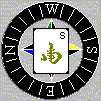 The
Prevailing Wind is South.
The
Prevailing Wind is South.
Player Wind
During each game, a player is assigned a wind type.
This Player Wind Type is different from the Prevailing Wind.
The banker
always has the East Player Wind for that game, and the player to the right of
the banker is the South
Player Wind. The player to the right of the South
Player Wind is the West player Wind, and the player to the right
of the West
Player Wind is the North player Wind. You can easily identify the player winds
of all the players by
looking at the compass on the game board. An example
is given below. In this example the player at the top has
the West Player
Wind.
 Player at the top has the West Player Wind
Player at the top has the West Player Wind
Starting the game
The 148 tiles are shuffled and each player
selects 13 tiles to start the game. Each player starts with 13 tiles
and
these tiles are not seen by the other players. These are called the players
concealed tiles. If a player has
a tile(s) in the animal or flower suit they
must put that tile up to show the rest of the players. These tiles
remain up
for the rest of the game and are referred to as the players exposed tiles. When
a player exposes
an animal or flower tile, they will take a replacement tile
from opposite end of the remaining unused tiles.
The player who is the banker for this game will start by taking another tile
from the remaining unused tiles.
At this point the banker has 14 tiles and
must discard a tile. The banker will discard a tile which is then shown
to
the rest of the players.
Playing the game
When a tile is discarded by a player, the other
players have the option of using that tile when it is first discarded.
The
different options for using discarded tiles are described below. If no one wants
to use that discarded tile, the
player to the right of the player who
discarded last picks a new tile and adds it to his down tiles. He in turn
will discard a tile.
Mahjong Moves
GAME MOVE
When a tile is discarded, any other player may decide
that they would like to win the game using that tile.
If more than one
person can win the game using that discarded tile then the person closest to the
right hand
side of the player (counterclockwise from the player) who
discarded the tile will have priority and win the game.
Further, the GAME
move has priority over the KONG, PONG, and CHOW moves. A player invokes this
move by clicking the GAME button. A player may not use a discarded tile to
GAME (win) if that same tile was
discarded previously and was not used by
that player after that players last move. A players last move is defined
by
any new tile, chow, pong, or kong that was performed by the player. A player may
not GAME on a tile that he
last discarded. If a player picks a new tile and
wants to win the game he may so by clicking the GAME button.
KONG MOVE
There are 3 unique ways to perform the KONG move.
Exposed Kong Type 1.
When a tile is discarded, and a player has 3
of the same tiles in his concealed tiles, he may declare a KONG
move by
clicking the KONG button. When this happens the 3 concealed tiles and the
discarded tile is moved
to the players exposed tiles and the player will
pick a replacement tile from the opposite side of the remaining tiles.
Exposed Kong Type 2.
When a new tile is picked by a player, and
there are 3 of the same tiles in his exposed tiles, he may
declare a KONG
move by clicking the KONG button. When this happens the new picked tile in the
concealed tiles is transferred to the exposed tiles and the player will pick
a replacement tile. Note, when a
player performs an exposed Kong Type 2, the
tile that is put in the exposed tiles is treated
as a discard for that
moment. Any other player can use that tile to win the game if they are able.
This is
called Robbing the Kong.
Concealed Kong.
When a new tile is picked by a player, and there
are 4 of the same tiles in his concealed tiles, he may declare
a KONG move
by clicking the KONG button. When this happens the new picked tile and the 4
other tiles
in the concealed tiles are transferred to the exposed tiles and
the player will pick a new tile.
If a player invokes the KONG move and more than one KONG move is possible,
the player must click
on the tile that they wish to KONG.
PONG MOVE
When a tile is discarded, any other player may decide
that he would like to PONG using that tile. When a
player PONG's a discarded
tile, the discarded tile plus two tiles from the players concealed tiles are
moved to
that players exposed tiles. A player may not use a discarded tile
to PONG if that same tile was discarded
previously and was not used by that
player after that players last move. A players last move is defined by any new
tile, chow, pong, or kong that was performed by the player. A player may not
PONG on a tile that he last
discarded. The GAME and KONG moves have priority
over the PONG move.
CHOW MOVE
When a tile is discarded, the player to the right of the
player who discarded may choose to CHOW the tile.
When a player CHOW's a
discarded tile, the discarded tile plus two tiles from the players concealed
tiles are
moved to that players exposed tiles.
The GAME, KONG, and PONG
moves have priority over the CHOW move. If the user decides to CHOW
there
may be multiple ways of obtaining the CHOW. The user should click on the tiles
that they wish to use
for the CHOW. A player may not CHOW on a tile that he
last discarded.
NEXT MOVE
If a player does not want to use the discarded tile, he
will click the NEXT MOVE button and play will proceed.
When is the game finished?
The game is finished when someone wins
the game or when there are 15 tiles left.
When a player picks that last
remaining new tile, he
may win the game on that tile or perform a KONG.
However he is not required to discard any tiles after he has
picked the last
tile. The computer game will ask for a discard (the player should click NEXT
MOVE) in this
situation, however the card is not actually discarded, the
game is finished at that point.
Types of Mahjong games
All Chow game
To have an All Chow game the following criteria must
be meet:
1. The EYE cannot be of the Dragon Tiles or the Prevailing Wind or
the Players Game Wind.
2. The tiles must be made up of one EYE and four
CHOWs.
3. If the player wins the game on a discarded tile, there must be
more than one unique
tile that could have caused the player to win the game
(get mahjong).
![]()
Ping Wu game
A Ping Wu game is an All Chow game with no tiles of
the flower suit or animal suit in the players
exposed tiles.
All Pong game
To have an All Pong game the tiles must be made of
an EYE and four PONG's and or KONG's.
![]()
Half Color game
To have a Half Color game you must have mahjong.
The tiles must be made of the either the
Bamboo suit, the Circle Suit, or
Numbers Suit combined with tiles from the Honor Suit (Winds and Dragons).
![]()
Full Color game
To have a Full Color game you must have mahjong.
The tiles must be made of the either the
Bamboo suit only, the Circle Suit
only, the Numbers Suit only, or the Honor Suit only.
![]()
All one's and nine's game
To have an All one's and nine's game you
must have mahjong. All the tiles must be a
combination of one's and nine's
only.
![]()
Half one's and nine's game
To have a Half one's and nine's game
you must have mahjong. All the tiles must be a
combination of one's and
nine's combined with the Honor Suit (Wind Suit and Dragon Suit).
![]()
13 Wonders game
To have 13 Wonders you must have the one and the
nine of the Bamboo suit, the Circle
Suit, and the Numbers Suit along with
each unique tile in the Honors suit. You must also
have an EYE which can be
made up of any of the above mentioned tiles.
![]()
Eight flower suit tile game
In the case that a player has all
eight Flower Suit tiles that person automatically wins the game
regardless
of their other tiles. If a player has seven Flower Suit tiles and another player
picks the eighth and last Flower Suit tile, this eighth Flower Suit tile is
automatically transferred
to the player with seven Flower Suit tiles and
that player automatically wins the game
regardless of his other tiles.
What is a double?
A double is something that will double the
number of points that can be won for that particular game.
Double values are
assigned to different tiles, tile combinations, and unique winning games.
Doubles
add together, such that if there are three tiles that are worth one
double a piece, the player has a
total of three doubles. Only the winning
player for each game gets credit for the doubles that they
have at the end
of the game.
How to get doubles?
There are many ways to get doubles during each
game. Below is a list of the different ways and the
values assigned to each
way.
A Pong or Kong of any the Dragon Tiles - 1 double for each
A Pong or Kong
of the Prevailing Wind for that game - 1 double
A Pong or Kong of the Player
Game Wind for that game - 1 double
All Chow Game - 1 double
Ping Wu Game
- 4 doubles
All Pong Game - 2 doubles
Half Color Game - 2 doubles
Full Color Game - 4 doubles
All one's and nine's game - 5 doubles
Half one's and nine's game - 1 double
13 Wonders Game - 5 doubles
Animal Suit tiles - 1 double for each
Complete set of the Animal Suit -
1 extra double (5 doubles total)
Flower Suit tiles that match the Players
Wind - 1 double for each
Complete set of Red Flower Suit - 1 extra double (2
doubles total)
Complete set of Black Flower Suit - 1 extra double (2 doubles
total)
Picking the winning tile after a flower suit or animal suit with a
replacement tile - 1 double
Picking the winning tile after a Kong Move with
a replacement tile - 1 double
Picking the winning tile on the last valid
tile left in the game - 1 double
Winning the game on a tile when another
player performs a Exposed Type 2 Kong (Robbing the Kong) - 1 double
Winning
the game with seven or eight flower suit tiles - 5 doubles
Winning the game
with a pong and/or a kong of each of the Dragon Tiles - 2 extra doubles (5
doubles total)
Winning the game with a pong and/or a kong of each of the
Wind Tiles - 3 extra doubles (5 doubles total)
Winning the game with a pong
and/or a kong of two of the three Dragon Tiles
and having the third Dragon
tile as the EYE - 1 extra double (3 doubles total)
Winning the game with a
pong and/or a kong of three of the four Dragon Tiles
and having the third
Dragon tile as the EYE - 4 doubles total
Minimum doubles to win the game.
There is a minimum number of
doubles that is needed for a player to win a game. The default setting
for
the game is 1 double, however this can be changed under the options menu.
Maximum doubles (Doubles Limit)
There is a maximum number of
doubles that is allowed for a player when they win a game. The default
setting for the game is 5 doubles, however this can be changed under the
options menu.
How does a player win the game?
To win the game, a player must
have mahjong and at least the minimum number of doubles.
The only exceptions
to this rule is when the player has 13 wonders or 8 flowers.
How do you score?
When a player performs an Exposed Kong (Type 1
or Type 2), they receive 2 points from each player.
This number can be
changed under the options menu.
When a player obtains all four tiles in the Animal Suit Tile set, they
receive 4 points from each player.
This number can be changed under the
options menu.
When a player obtains all four tiles in either the Red Flower Set or the
Black Flower Set, they
receive 4 points from each player. This number can be
changed under the options menu.
When someone declares Mahjong and wins the game, the number of doubles they
have is counted.
If they have no doubles they receive 1 point from each
player. By default this cannot happen
in the game because the minimum
doubles limit to win the game is set to one. If the winning player
has one
or more doubles, 1 point is doubled for each double the winning player has. This
number of points is received by the winning player from each player. If the
winning player
picked the winning tile from the unused tiles, then they
receive double the calculated points. If the
winning player won via a
discarded tile, then the winning player receives double the points from
the
player who discarded the winning tile. Example, player 1 wins the game with 3
doubles and
Player 2 discarded the winning tile. Player 1 receives 16 points
from Player 2 and 8 points
(1 x 2 x 2 x 2) from the rest of the Players.
Another example, if Player 1 wins the game with
3 doubles and player 1
picked the winning tile from the unused tiles, then Player 1 receive 16 points
from each player.
When a player wins with a 13 Wonders Game, the scoring is treated as if he
picked the winning tile
himself, even if the winning tile was thrown by
another player.
When a player gets the cat and the mouse in the animal suit they receive 2
points from each player.
If the cat and the mouse were received during the
initial 13 tiles at the beginning of the game, the
player would receive 4
points from each player. This number can be changed under the options menu.
When a player gets the chicken and the centipede in the animal suit they
receive 2 points from each player.
If the cat and the mouse were received
during the initial 13 tiles at the beginning of the game, the
player would
receive 4 points from each player. This number can be changed under the options
menu.
When a player gets both flowers that match his wind number for that game they
receive 2 points from
each player. If the these flowers received during the
initial 13 tiles at the beginning of the game, the
player would receive 4
points from each player. This number can be changed under the options menu.
Pay all situations.
There are a number of game situations where
discarding a particular tile may result in that player
paying for all the
other players. These game situations are described below.
Dragon Tile Set Scenario
If player A has a Pong or a Kong of 2 of
the 3 Dragon tiles showing in his exposed tiles, and a discard
by player B
of the Dragon tile (that is not currently showing in player A's exposed tiles)
would cause player A
to Kong, Pong or Game where player A now has the
completed Dragon tile set, then player B would
pay for all the other players
if player A won by picking his own winning tile or player B threw the winning
tile to player A.
An example of this scenario is shown below and is as follows. Assume player A
has the exposed tiles as
shown below. If player B discards the White Dragon
and Player A Pongs or Kongs on that tile, then player B
is in a pay for all
situation. In this case if player A wins by picking his own winning tile or
player B causes
player A to win with a discarded tile, player B will pay for
all the other players.
![]() With
these exposed tiles for Player A, the White Dragon is now a pay all
With
these exposed tiles for Player A, the White Dragon is now a pay all
discard.
Wind Tile Set Scenario
If player A has a Pong or a Kong of 3 of
the 4 Wind tiles showing in his exposed tiles, and a discard by player B
of
the Wind tile (that is not currently showing in player A's exposed tiles) would
cause player A to Kong,
Pong or Game where player A now had the completed
Wind tile set, then player B would pay for all the other
players if player A
won by picking his own winning tile or player B threw the winning tile to player
A. An example
is shown below.
![]() With these exposed tiles for Player A, the North Wind
With these exposed tiles for Player A, the North Wind
is a pay all discard.
Double Limit Scenario
If player A has the number of Doubles Limit
(default to 5) showing in his exposed tiles, and player B discards a Dragon
Tile, Prevailing Wind Tile, or Players Game Wind that causes player A to win
the game or Pong or Kong, then player B
would pay for all the other players
if player A won by picking his own winning tile or player B threw the winning
tile
to player A.
If player A has the less than the Doubles Limit showing in his exposed tiles,
and player B discards a Dragon
Tile, Prevailing Wind Tile, or Players Game
Wind that causes player A Pong or Kong and it brings player A to the
Doubles
Limit, then player B would pay for all the other players if player A won by
picking his own winning tile
or player B threw the winning tile to player A.
This rule also applies if player A were to win the game with the
discarded
tile that was used in a PONG to win the game and bring player A to the Doubles
Limit.
![]() Player A has 4 doubles on the exposed tiles which is one less than the
Player A has 4 doubles on the exposed tiles which is one less than the
Double Limit of 5. Therefore any Dragon Tile, Prevailing Wind tile, or
Players Wind tile is a pay all discard.
Full Color Scenario
If player A has 3 or 4 sets of Chow's, Pong's,
or Kong's that are all in the same suit in the exposed tiles,
and player B
throws a tile of that same suit that causes that player to win the game, then
player B will pay for all
the other players.
![]() Player A has 3 sets of the same suit on the exposed tiles,
Player A has 3 sets of the same suit on the exposed tiles,
therefore any Bamboo Suit tile becomes a pay all discard.
End of Game Scenario (Fresh Discard Scenario)
When there is less
than 7 tiles to play in the game, any player that discards a tile that is not
contained in the discarded
tiles which causes another player to win the
game, the player who discarded the "fresh" tile will pay for all. The number
of tiles that this rule applies to can be set in the options menu.
In the case where multiple players encounter the pay all scenario, the player
that last encountered it would be the
one who would pay for all.
The help menu will tell you all the discard tiles that could possibly cause a pay all situation at any point in the game.
Rule Variations
This is a list of known rule variations in
Singapore. I am sure there are many more.
Pay all End of Game - Some games play that the pay all situation does not
occur until after 4 tiles are remaining
This is selectable under the Options
menu.
Pay all for Kong at the End of Game - Some games play that any fresh tile
that causes a KONG at the end of
the game (usually fewer than 7 tiles
remaining) is pay all for the Kong for the person who threw the tile. This
computer game does not support this rule.
Robbing the Kong for Concealed Kong on 13 wonders - If a player invokes a
concealed Kong and another
played needs that tile to GAME for 13 wonders
that tile is transferred to him from the KONG and he wins
the game with 13
wonders. This rule is not supported by this game.
Extra double for concealed game - Some games play that when a player games
with no exposed tiles
showing (excluding animals and flowers) and he picks
the winning tile himself, he gets an extra double.
This rule is not
supported by this game.
Extra points for self draw winning - Some games play when a player wins a
game by picking the winning tile
himself, extra points are received from
each player. This rule is not supported by this game.
Winning with Dragon or Wind Set - Some games play that once a PONG and or KONG
of the Dragon or
Wind set is obtained by a player he automatically wins the game without having
to obtain Mahjong.
Rules of Mah-jongg for 2 players or 3 players.
HOW TO PLAY AMERICAN-STYLE MAH-JONGG WITH ONLY 2 OR 3 PLAYERS
American style 3 players -- Build 4 walls. Deal 13 tiles to each player
(14 to the dealer) as normal. Just skip the empty seat (nobody is West, for
example) -- do not deal tiles to the empty seat. Skip the Charleston, just
go straight to the dealer's first discard.
American style 2 players -- Same. Sit opposite each other. Build 4
walls. Dealer has 14 tiles, opposite player has 13 tiles (as usual). No Charleston.
No dummy seats.
"THE TURTLE"
"The Turtle," or "Shanghai"
- Remember that there are four of each tile. When removing a pair, remember
that an identical pair exists in the layout. Is it trapped by your removal
of the first pair? Choose wisely.
- Concentrate your efforts on long rows and tall stacks.
- Plan ahead as many moves as you can.
- If all four of a tile are available, remove them all to unclutter the
field.
- Identify as many matching pairs as possible. Check for tiles that need
to be unblocked.
- Beware of triples (three matching free tiles); choose carefully which
pair you remove. Leave the one that's blocking the least important tiles.
- Concentrate on removing pairs that will unblock the most tiles.
Flowers and Seasons are non-identical matching tiles. All the flower tiles
match one another; all the season tiles match one another; flowers do not
match seasons. If you can't tell the flowers from the seasons, just leave
some of them out, or substitute other special tiles that may or may not
be included with your set. Just set a table rule that says "these 4 tiles
match one another."
1. Stack the tiles randomly into a pyramid shape or a turtle shape
(actually, any shape structure you like is fine). It is usual to stack all
the tiles face up.
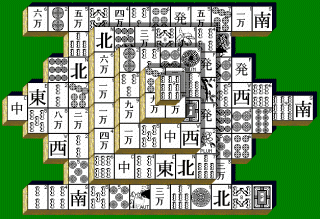
This is the typical layout used by most computer "mah-jongg solitaire" games.
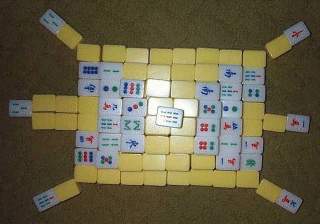
Note how (1) blocked tiles are turned face-down (you turn them face-up only when they become unblocked), and (2)the tiles are oriented horizontally. If you want to use this "tortoise" layout ...
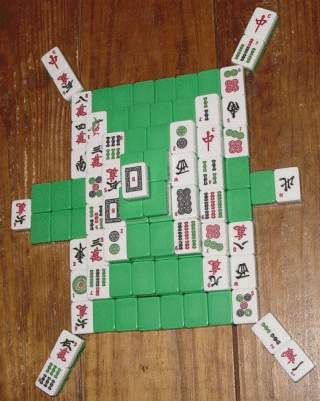
... then I recommend this vertical orientation of the tiles. Reason: it's easier to slide a tile out when there is less surface contact along the shorter edges.
2. There are four of each tile, which can be removed as two matching
pairs. The object is to remove all the tiles from the layout, one pair
at a time. To remove a pair, the tiles must both match and be "free"
at the same time. A tile is considered free if no other tile is on top of
it and if it can slide out to the left, to the right, or in both directions.
If a tile can only slide toward the top or the bottom of the layout, it
is not free to be removed. It's that simple. But wait - because there are
four of each tile, you may well find yourself stuck, with unmatchable tiles
blocking other key tiles so you can't clear the layout. As you continue
to play game after game, you will form your own winning strategies. Because
you are not playing on the computer, you can't undo previous matches and
try to fix any mistakes, shuffle the remaining tiles, or put them all back
to the way they were at the beginning so you can try again.
3. If you get stuck, mix the tiles all up and repeat from step 1.
4. If you win, follow the direction in step 3 above.
STRATEGY
TWO-PLAYER
Although this game is often referred to as "solitaire," you can easily play it with 2 or more people. There are several ways you can do this:
A. Cooperative. No special rules -- just work the puzzle together.
B. Competitive. Several ways to go here:
i. Speed free-for-all. The two of you attack the layout together, removing pairs. When you remove a pair, put it on your side of the table. At the end (when the layout is clear or unwinnable) the player with the biggest pile of tiles wins.
ii. Taking turns. Each player gets a turn at removing a pair. A player's turn ends when the player removes a pair or the player concedes (cannot see a pair to remove). Game ends when the layout is cleared or unwinnable by mutual agreement. Player with biggest tile pile wins.
iii. Time-limited turns. Get a one-minute timer. Start it at the beginning of each player's turn. Inevitably, some turns will result in a match being removed and some won't. At the end (when the layout is clear or unwinnable) the player with the biggest pile of tiles wins.
SHISENSHO
-
This game is also sometimes called "Szechuan" or "Four Rivers" - Szechuan
being the Chinese name for an area in China, Shisensho being the Japanese
name of the same area, and Four Rivers being an English translation of that
name. You can find computer versions under other titles also: The Curse of
Ra (Rah-Jongg), Nikakudori, Winojong, RongRong...
Here's how Shisensho is played.
1. First, you arrange tiles randomly, usually in a rectangular grid (but other patterns are also perfectly fine). Don't use all 144 tiles. Just use one suit, or one suit and the winds. Or one suit, the dragons, and the winds and flowers. Whatever number you like. But make sure that you always use all 4 of any tile that you include in the layout, else the game will not be winnable!
2. Now you're ready to play. The goal is to remove all the tiles (just as in The Turtle AKA Shanghai). As in Shanghai, you remove them by matching identical tiles. But, the rule is that tiles can only be removed if they can be connected by an imaginary line - an imaginary line with no more than two right-angle bends in it. The line cannot pass through any tiles (the line must pass through empty space only).
Let's see some examples that illustrate this point.
Here (below) is a rectangular layout using 96 tiles (12 columns, 8 rows). See if you can spot the matching tiles that can be matched, according to the rule outlined above. Try to do it without peeking at the solution, farther below.


On the left, you can match the 6 Dots and the 9 Dots. Along the top, you can match the 6 Bams and the 1 Dots. On the right, you can match the Green Dragons, and along the bottom, you can match the 2 Dots. two 1 Bams (the bird) at the bottom right corner area Those cannot be matched. It would require a line with three right-angle bends, and that would be in violation of the rules.
As you clear away tiles at the edges, other tiles become available for matching. Take a look at the next example, and see if you can find the available moves.

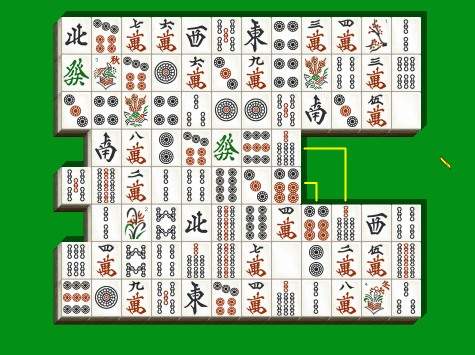
Now there are two moves available - the 6 Dots and the 7 Bams. After clearing those away, there will be a move with 3 Dots. Then 8 Dots, then 4 Bams, then 2 Bams...
sometimes you will be starting with non-rectangular layouts:

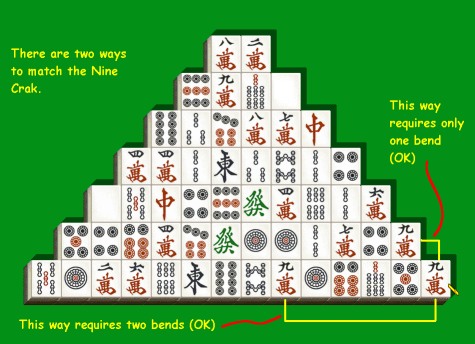
CATCHING THE TORTOISE
Take all the tiles of one suit (any one suit). Shuffle them face-down. Line them up in a block, nine tiles wide by four tiles high.
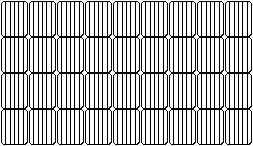
Take any tile from the top row and look to see what number it is.
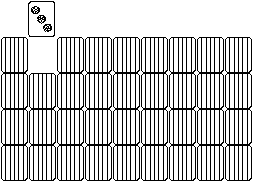
It's the number three, so count three tiles from the left, and place the tile above the third column of tiles.

Now push it towards you, forcing a tile out the bottom of the column.
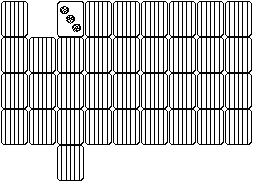
Take that extra tile, observe its number, and put it in its proper column.
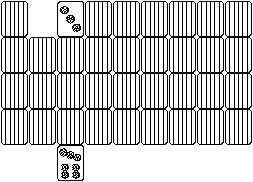
It's a seven, so we put it on the seventh column.
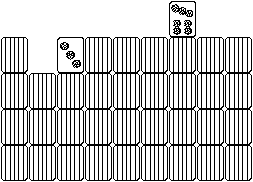
Keep doing this until you have either created an organized face-up block of tiles or you are unable to do so. (You can get stuck if you complete the first column, the one you first opened, before finishing the rest of the block.)
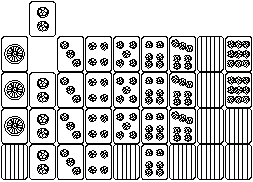
Stuck. The last tile pushed out the bottom was a two, completing the second column.
When this doesn't happen, you should wind up with a fully complete arrangement as shown below.

As many as three people can play this game simultaneously (since there are three suits in a set). Each player gets the tiles of one suit. It's a race to see who can finish, or who can finish first. apply points commensurate with the system you use for regular mah-jongg.
four can play at a time. While three players get the 36 tiles of one suit each, the fourth player can get the 36 tiles made from the winds, dragons, flowers, and seasons. What we do is just expose the tiles as in regular play, but then each wind or dragon is placed in the next available column, until all columns have been identified.The tricky part is how to handle the flowers and seasons. In most sets, these are distinguishable only by the differing colors of the numbers. For example, the flowers might be numbered in blue, while the seasons are numbered in red. Or the flowers' numbers might be in the left corner, while the seasons' numbers are in the right. Some sets have four animal tiles and four flower tiles - or these tiles might be labeled with abbreviations for season and flower names. Or maybe your set has four blanks, or four jokers you can use. Depending on your tiles, you should be able to find a way to distinguish one set (seasons) from the other (flowers).
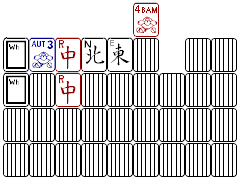
In this example, the first tile I got (from the 7th column) was White. I put it into the 1st column. That pushed out a blue flower (clearly marked as a Season, with the number in the right corner), which went into the 2nd column. After pulling an East, which went into the 5th column, the next tile was a red flower (marked with flower names - "bamboo" being one of the traditional flowers - and with the number in the left corner). It's easy, and fun! The kids like it.
-
a trump game played with mah-jongg tiles. Paihinmin can be translated
as "poor people ranking." It's based on a hierarchy of the tiles in the mah-jongg
set as follows. Two to four players.
The strongest tile in the set is the Nine Crak, followed by the Nine Dot, then the Nine Bamboo, and so on.

After the Ones, the hierarchy goes down through the winds (E, S, W, N) then the dragons (W, G, R). So the weakest tile in the set is the Red Dragon. Flowers and jokers are not used (this game is designed for the Japanese tile set of 136 tiles.)
Build four mah-jongg walls of 17 stacks each. Each player takes one entire wall. Line them up as best you can, standing on end (they won't all fit on American-style racks), in order of strength, suit, etc. With the dice, determine who will go first (high roll). That player must make some sort of tile combination, face-up on the table. A single tile, a pair, a pung, kong, or chow. In turn, each player then must trump the exposure made by the first player. Your trump must be in the same form as the play made by the preceding player (for example, if he plays a pair, you cannot play a chow or pung, you also must play a pair, only yours must "rank" higher). If the preceding player makes a 4-5-6 chow in Bams, the next player could make a 4-5-6 chow in Dots or Craks -- or could make a 5-6-7 chow.
When a player wins a trump, all exposed tiles are moved aside, and that player (the one who won the trump play) makes an exposure.
When a player cannot trump a play, he passes. If all four players pass, the last player who made an exposure makes another exposure.
The winner is the player who uses up all his tiles while other players still have tiles in the hand.
You can read the rules for Sap Tim Pun (Ten And A Half), a game very
much like Blackjack or Twenty-One which can be played with either mah-jongg
tiles or playing cards, at http://www.mahjongmuseum.com/saptimpn.htm.
2P or 3P RULES FOR CHINESE CLASSICAL OR MOST OTHER ASIAN FORMS OF MAH-JONGG
Asian styles for 3 players (you can use these rules for Chinese, Japanese, Filipino, Taiwanese, HK, etc.) -- Build 4 walls. Deal 13 tiles to each player (14 to the dealer) as normal. Just skip the empty seat (nobody is North) -- do not deal tiles to the empty seat (exception: Taiwanese players deal a dummy hand to the empty seat; it is never used). Player sitting to right of empty seat may chow from opposite player. Some people prefer to leave out the North tiles and the #4 flowers and all the Bams, and build only 3 walls (and play only 3 rounds, omitting the North round). You can also click here to jump to http://koreanmahjong.ce.ro/ where the Korean 3-player rules are described. You may use any 3-player rules that the three of you agree to use;
Chinese style 2 players -- Build 4 walls. Dealer has 14 tiles, opposite
player has 13 tiles (as usual). No chow exposures allowed. Leave the flowers
out if you normally use flowers.
Western style mah-jongg (including Wright-Patterson) -- omit the Charleston.
Disallow chow exposures if playing 2P. If you use jokers and flowers, omit
them.
JAPANESE "REACH" MAH-JONGG FOR 3 PLAYERS
Remove the Craks, except the 1s, 5s, and 9s. The Craks and Norths act like
flowers. There is no North player (deal only to the other three). Deal always
passes to the winner. It's always the East round. Scoring is in Points, not
Fan (for each Fan, count 1 point). Each flower is 1 point.